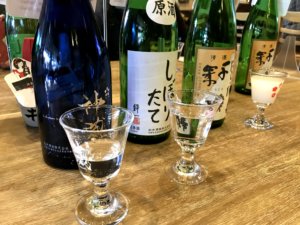January and February are midwinter in Japan, and people prefer to eat warm dishes such as oden and hot pot. Hot sake is the ideal drink during such a cold winter. Sake is generally served chilled, but during the cold season, why not warm yourself up by drinking hot sake instead of cold sake?
The history of heating sake goes back as far as the Heian period (794-1192), when people were already warming sake to drink. Even from a global perspective, it is very rare to drink alcohol by heating it, making it a unique part of the Japanese culture. In this article, we will introduce how to enjoy hot sake and how to choose the best sake for heating!
Benefits of Heated Sake
Effects on the Body
In Japan, people often say that heating sake up can give you a hangover, increase the feeling of alcohol, or make you easily intoxicated. It is true that hot sake is absorbed quickly by the body, so if you drink it all at once, you will get drunk faster. However, in reality, the faster the absorption of alcohol compared to cold sake, the faster the alcohol is broken down, which actually helps prevent hangovers.
Cold sake feels even easier to drink if it is light and fruity, but the alcohol content of sake is higher than that of beer or wine. However, the alcohol content of sake is higher than that of beer or wine, so it is easy to become quite drunk before you know it. On the other hand, hot sake is closer to human body temperature, so you feel intoxicated more quickly than with cold sake. This helps prevent over drinking. Hot sake also helps relieve stress and fatigue by warming the body.
Differences in Taste
Sake contains a variety of tastes, including sweetness and umami from the rice, sourness and fruitiness from the koji and yeast, and bitterness. You can taste many flavors in one sip. Basically, cold sake has a sharp, clean taste and a fruity aroma. On the other hand, hot sake is richer and richer, and the alcohol content is slightly reduced by heating it, giving it a mellower impression.
The Japanese word for “taste” is “gomi” (five tastes), which means “sweet, umami, bitter, sour, and sweet, The five tastes of sweetness, umami, bitterness, acidity, and saltiness are perceived differently depending on the temperature. For example, umami and sweetness are moderately different from each other. For example, umami and sweetness are perceived more strongly when the sake is warmed to a moderate temperature, while bitterness is perceived less strongly. The acidity component itself does not change much with temperature, but as the sweetness increases, the acidity is perceived as milder, resulting in a sweeter taste. Thus, heating sake increases its umami and sweetness, while reducing its acidity and bitterness, making it mellower and inherently easier to drink.
The temperature at which it is heated can vary widely, from about 35°C to 55°C, and the way the flavor is enhanced changes depending on the temperature range. For example, since sweetness and umami can be best appreciated at human body temperature, lukewarm heating at 35-40°C makes it very easy to drink, When heated to 45-55°C (45-55°F), the volume of the flavor becomes stronger and the taste becomes sharp and dry.
Another way to enjoy sake is to match the temperature of the food with that of the sake at mealtime, or to try heating it up to a very hot temperature on a particularly cold day.
How to Heat Sake and the Best Types of Sake
There are several ways to warm sake, but the best and most common way is to boil it in hot water. To warm sake, simply place a tokkuri or chirori filled with sake in a pot of boiling water or kettle, and wait for the sake to warm up. Let the sake sit for about 2 minutes when lukewarm (around 40°C) or about 3 minutes when hot (around 50°C). Watch carefully the sake and pour it into a sake cup and just enjoy. In addition to boiling, it can also be heated in a microwave oven. If using a microwave, be careful not to overheat. If it is heated to the point of almost boiling, the balance of flavors will be lost and the bitter taste and tangy smell of alcohol will appear.
The best sake to heat up is generally junmai or honjozo, which has a strong flavor and low rice polishing ratio, rather than ginjo-shu, which has a strong aroma and high rice polishing ratio.
How to Enjoy Heated Sake
One of winter’s best pleasures, heated sake has a different charm when paired with winter dishes. One such dish is “Hire-sake”. Fugu (blowfish) is mainly eaten in the Kansai region, and is in season from November to February, with fugu nabe being a special dish. The fins (hire in Japanese) of the fugu are dried and seared, then added to hot sake. The flavor and savory aroma of the fins melts into the hot sake, making it a perfect match for fugu nabe.
Another one I would like to introduce is “Dashiwari”. This is a good way to enjoy pairing of oden and hot sake during the cold season. The recipe is simple. All you have to do is mix the hot sake and dashi (Japanese soup stock made from fish) from the oden in a 1:1 ratio. The flavor of the rice and the broth will match beautifully, and the alcohol content will drop a little, making it very easy to drink sake. If you like, you can add a little shichimi (seven spices) or yuzu peel to make it more aromatic and enjoy the difference in taste.
There are many ways to enjoy hot sake, depending on the type of sake you choose and the temperature range. The cold season is still to come, so let’s get warm this winter with some hot sake. If you are interested in learning more about and enjoying sake, why not join the Kyoto Insider Sake Experience?
When Visiting Fushimi Kyoto, Don’t Miss Our Sake Tasting Tour!
When visiting Kyoto, you can’t miss a sake tour of Fushimi – so why not join us on a hunt for the area’s best sake, and best combination with food pairing session and find your favourite along the way?

Visiting a bar or sake shop and don’t know which sake to buy or taste? Join our Sake Tasting and Pairing Experience!
In this experience, you will learn all the basics about sake and be able to compare different types of sake to find the differences and get to discover how to truly enjoy sake. Joining our sake tasting tour is surely a great introduction to your sake experience. Discover Japan’s real sake & food culture and traditions!

